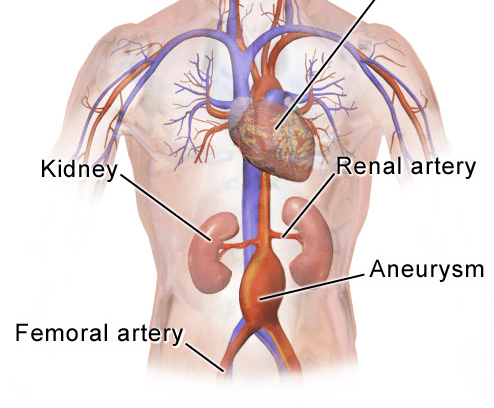Abdominal aortic aneurysms – the silent killer

Abdominal aortic aneurysms (AAA) may not be a well-known medical condition, but they are responsible for over 175,000 deaths worldwide every year and can kill within minutes. AAA are localised areas of dilation in the walls of the aorta – the body’s largest artery. Of all AAA, 80% occur in the area between the renal (supplying blood to the kidneys) and iliac arteries (transporting blood to the lower limbs), commonly referred to as the ‘infrarenal region’. So how exactly do these types of aneurysms occur and what can we do to prevent them?
The aorta is a strong and elastic vessel, which is important as it must withstand blood being pumped from the heart at high pressures, but there are regions where there is less collagen and elastin and so the vessel is weaker in these areas. This infrarenal region is one such area of weakness. Over time, what was once a strong and compliant artery can become rigid, causing a section of the vessel wall to permanently dilate. It is this expansion of the walls that, over time, can lead to a sudden rupture.
The NHS categorises AAA according to size and therefore risk of rupture. An aneurysm of between 3.0 and 4.4cm is small, only requiring follow-up scans every 12 months. Medium aneurysms are typically between 4.5 and 5.4cm. These require more careful monitoring, usually every 3 months to check their size and progression. Dilations of 5.5cm and greater are clinically classified as large and are referred for surgical intervention1.
Men are six times more likely than women to develop AAA2 and whilst it is true that AAA predominantly affect those over the age of 65, it is important to understand the risk factors associated with this life-threatening condition. If you are a current smoker or have ever smoked 100 cigarettes or more, you are at an increased risk of developing an AAA. Cardiovascular disease, such as coronary artery disease, also indicates increased risk and is often found in combination with high blood pressure. However, it is not just lifestyle factors that play a role in the progression of this condition. Genetics is also a vital component; if any immediate family members has AAA, then you are 4 times more likely to have one.
The latest statistics from NHS Scotland published in March 2019 showed that of the 25,521 men tested, 324 were found to have an AAA3. AAA have an 80% mortality rate and there is no doubt that these screening services, wherein tests are conducted to check for such risks, save lives. Since there is such a distinct difference, AAA screenings are offered predominately to older men.
The average uptake of screening for AAA is 84.5%, above the NHS’s target of 75%. However worryingly, the number of those accepting screening invitations was lower in deprived areas of Scotland, meaning more must be done to educate those men most at risk.
Edited by Frankie Macpherson
References
- See more at: www.nhs.uk/conditions/abdominal-aortic-aneurysm-screening/
- Further information found online: www.isdscotland.org/Health-Topics/Public-Health/Publications/2019-03-05/2019-03-05-AAA-Publication-Report.pdf
- Further information found online: www.isdscotland.org/Health-Topics/Public-Health/Publications/2019-03-05/2019-03-05-AAA-Publication-Report.pdf










